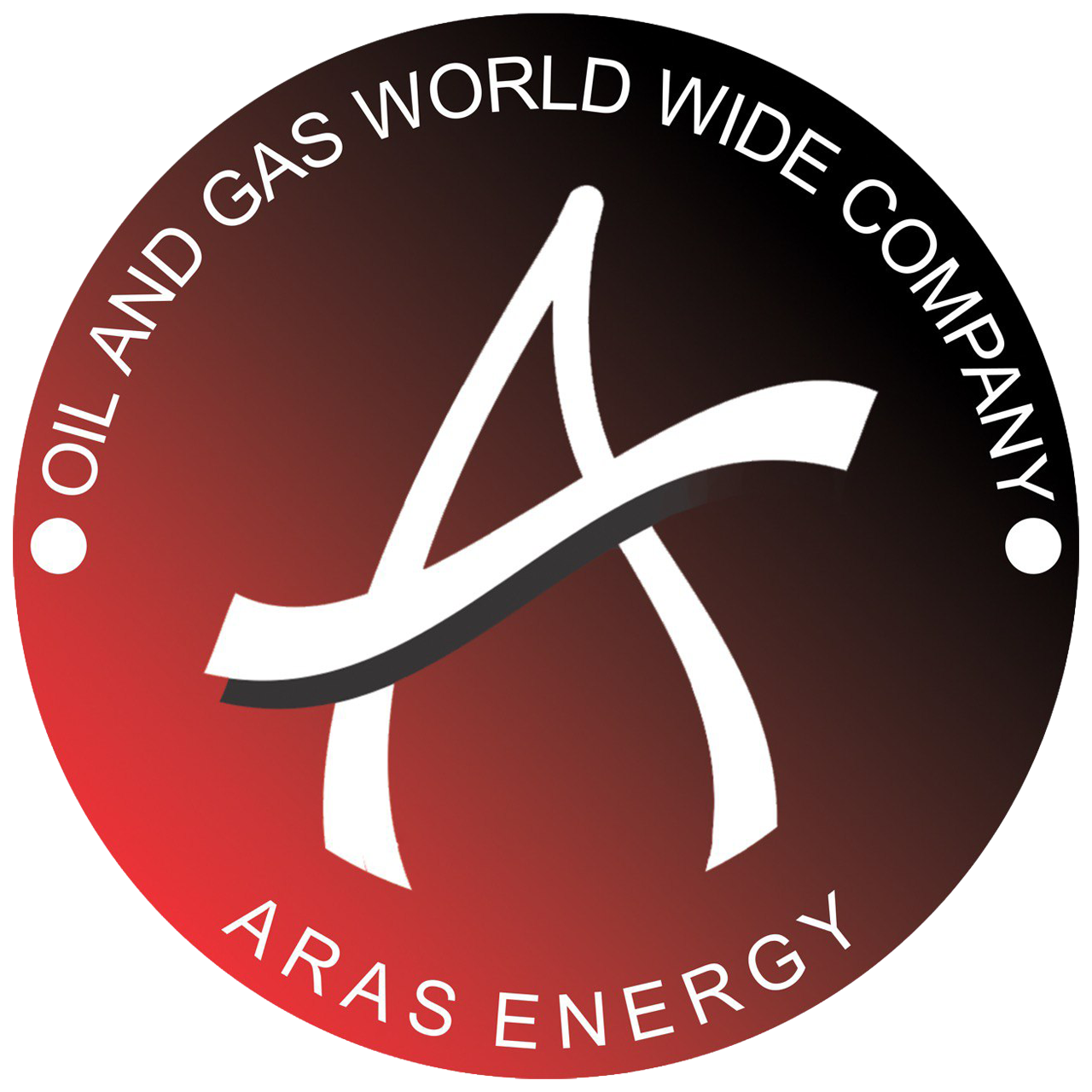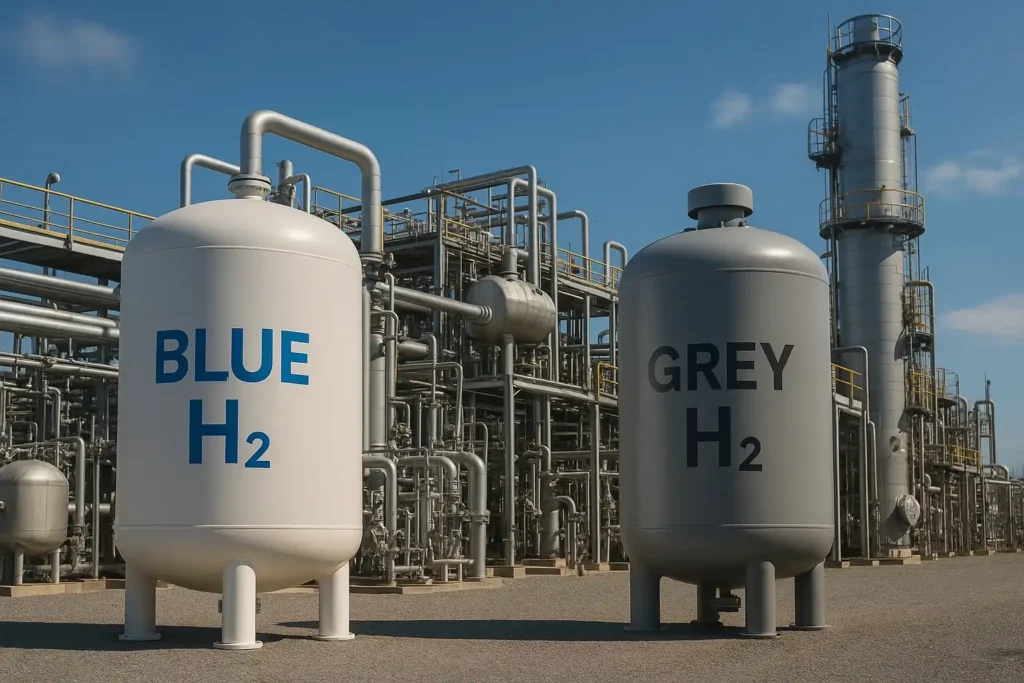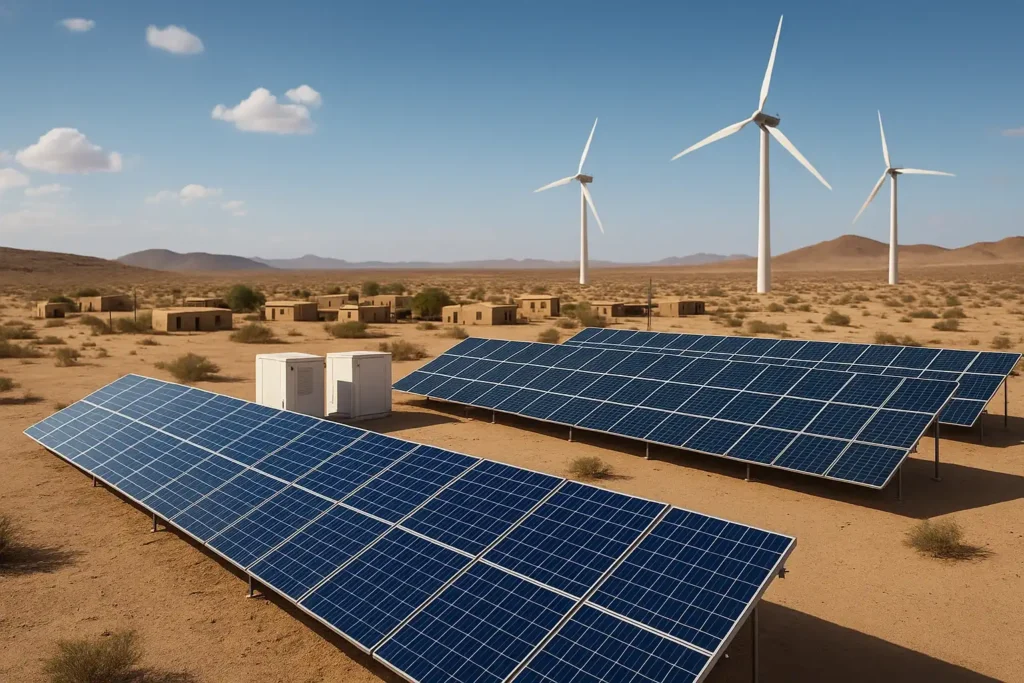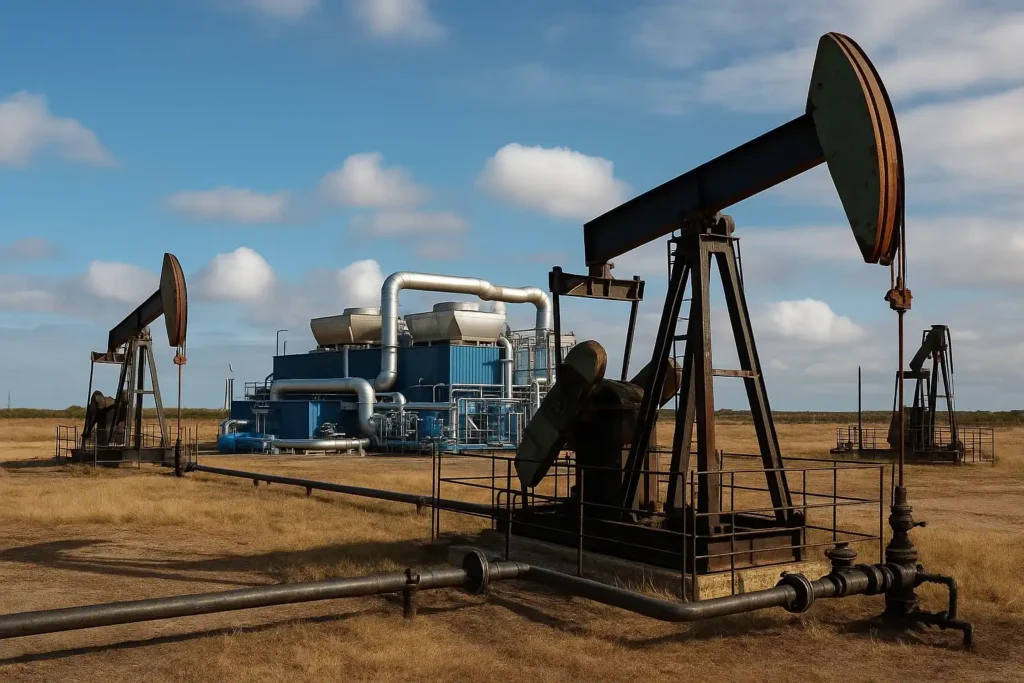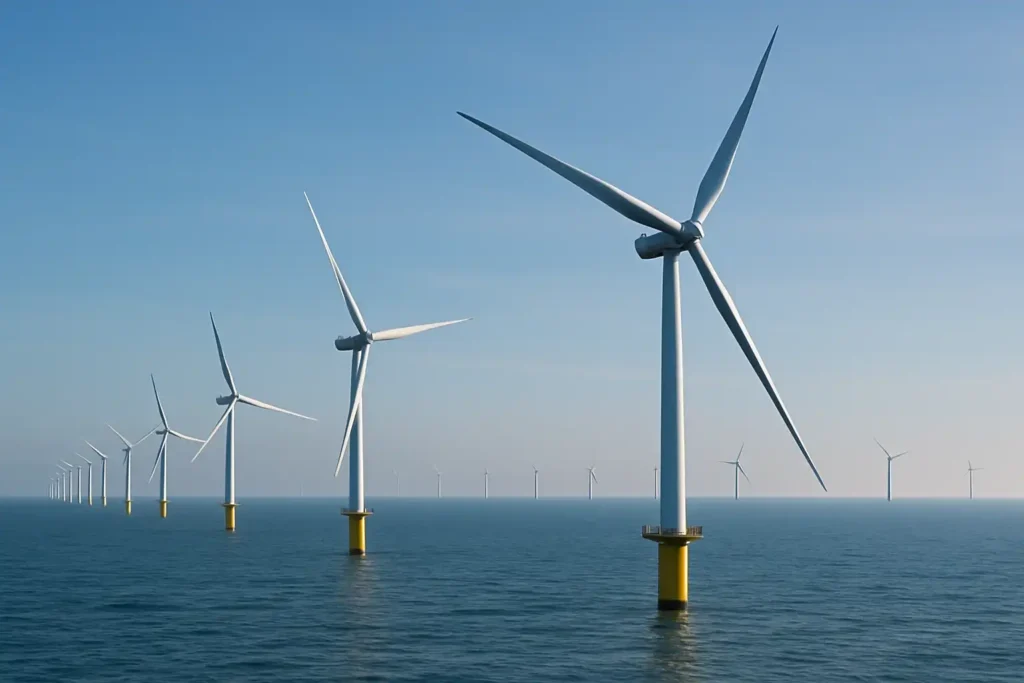Hydrogen is a versatile energy carrier with applications ranging from refining and chemical synthesis to power generation and mobility. However, traditional “gray” hydrogen—derived from natural gas reforming—accounts for substantial CO₂ emissions. Green hydrogen replaces fossil inputs with electricity from wind, solar, or hydropower, splitting water (H₂O) into hydrogen (H₂) and oxygen (O₂) without direct carbon emissions. As renewable capacity expands and electrolyzer costs decline, green hydrogen is poised to play a pivotal role in achieving net‑zero targets by mid‑century.
Green Hydrogen Production Technologies
Producing green hydrogen hinges on efficient, scalable electrolysis. The main electrolyzer technologies are:
Alkaline Electrolyzers (AEL)
- Operation: Use a liquid alkaline electrolyte (e.g., potassium hydroxide) between two electrodes.
- Advantages: Mature technology with low capital costs; proven industrial track record.
- Limitations: Relatively slow dynamic response to fluctuating renewable inputs; larger footprint.
Proton Exchange Membrane (PEM) Electrolyzers
- Operation: Employ a solid polymer membrane that conducts protons, separating the hydrogen and oxygen compartments.
- Advantages: High current density; rapid response to variable power; compact design.
- Limitations: Higher capital costs; reliance on precious metal catalysts (e.g., platinum, iridium).
Anion Exchange Membrane (AEM) Electrolyzers
- Operation: Similar to PEM but conducts hydroxide ions, potentially allowing non‑precious metal catalysts.
- Advantages: Emerging technology promising lower catalyst costs; improved energy efficiency in laboratory settings.
- Limitations: Technology still at pilot scale; membrane durability challenges.
Solid Oxide Electrolyzers (SOE)
- Operation: Operate at high temperatures (700–900 °C), using a solid ceramic electrolyte to conduct oxide ions.
- Advantages: Highest electrical-to-hydrogen efficiency (up to ~90%); can utilize waste heat from industrial processes.
- Limitations: High operating temperatures lead to materials degradation; complex thermal management.
Integration with Renewable Energy Sources
Green hydrogen production is most cost‑effective when powered by variable renewables:
- Utility‑scale wind and solar farms can sell electricity to electrolyzer plants during periods of surplus generation, mitigating curtailment and improving asset utilization.
- Co‑location models, where electrolyzers are sited alongside generation assets, reduce grid connection costs and transmission losses.
- Hybrid renewable systems, combining wind, solar, and battery storage, can deliver more consistent power to electrolyzers, smoothing production and lowering LCOH (Levelized Cost of Hydrogen).
Dynamic operation—ramping electrolyzer load up and down—can provide grid-balancing services, creating additional value streams for hydrogen producers.
Hydrogen Distribution Methods
Moving hydrogen from production hubs to end users requires careful consideration of volume, distance, and mode:
- Pipelines
- Pros: Most economical for high-volume, long-distance transport; existing natural gas pipelines can be retrofitted for 10–20% hydrogen blending.
- Cons: Hydrogen embrittlement of steels; leak detection and regulator permitting are challenges.
- Pros: Most economical for high-volume, long-distance transport; existing natural gas pipelines can be retrofitted for 10–20% hydrogen blending.
- Liquefied Hydrogen Shipping
- Pros: Enables intercontinental trade; liquefaction reduces volume by ~1/800.
- Cons: Energy-intensive liquefaction (~30% of hydrogen’s energy content); boil-off losses; specialized cryogenic vessels.
- Pros: Enables intercontinental trade; liquefaction reduces volume by ~1/800.
- Ammonia Carriers
- Pros: Ammonia (NH₃) is easier to liquefy at moderate conditions and has established shipping infrastructure; can be “cracked” back into hydrogen at import terminals.
- Cons: Cracking process adds cost and energy consumption; ammonia’s toxicity requires strict handling.
- Pros: Ammonia (NH₃) is easier to liquefy at moderate conditions and has established shipping infrastructure; can be “cracked” back into hydrogen at import terminals.
- Compressed Gas Trailers and Rail
- Pros: Flexible for small‑scale deliveries and remote locations.
- Cons: Lower volumetric efficiency; more expensive per kilogram for large distances.
- Pros: Flexible for small‑scale deliveries and remote locations.
Hydrogen Storage Solutions
Ensuring reliable supply and balancing production fluctuations demands robust storage:
- Compressed Gas Storage (350–700 bar) in above‑ground or underground cavern vessels; suitable for short‑term buffering.
- Liquid Hydrogen Tanks at –253 °C; best for high‑density, long‑duration storage but incurs boil‑off.
- Underground Caverns in salt formations or depleted fields; offer low‑cost, large‑scale storage capacity and seasonal buffering.
- Chemical Carriers such as ammonia, LOHCs (Liquid Organic Hydrogen Carriers), or metal hydrides; bind hydrogen for safer, denser storage.
Selecting the right storage depends on scale, duration (hourly to seasonal), and geography.
Infrastructure and End‑Use Applications
Transitioning to a green hydrogen economy requires tailored infrastructure across sectors:
- Industrial Clusters
- Refineries and Petrochemicals: Replace gray hydrogen in hydrocracking and ammonia synthesis.
- Steel and Cement Plants: Direct reduction of iron (DRI) processes powered by hydrogen can displace coke.
- Refineries and Petrochemicals: Replace gray hydrogen in hydrocracking and ammonia synthesis.
- Power Generation
- Gas Turbines: Co-firing or full firing with hydrogen to provide firm, dispatchable power.
- Fuel Cells: For distributed generation and data centers, offering high efficiency and zero local emissions.
- Gas Turbines: Co-firing or full firing with hydrogen to provide firm, dispatchable power.
- Mobility
- Heavy-Duty Transport: Fuel cell electric vehicles (FCEVs) for trucks, buses, and trains, leveraging fast refueling.
- Maritime and Aviation: Ammonia and synthetic fuels derived from green hydrogen enable lower‑carbon shipping and flight.
- Heavy-Duty Transport: Fuel cell electric vehicles (FCEVs) for trucks, buses, and trains, leveraging fast refueling.
- Refueling Stations
- Compression, Cooling, and Dispenser Units: Must meet safety standards (ISO 19880 series) and integrate with billing systems.
- Clustered Hubs: Co-locate with fuel stations, electric charging, and maintenance facilities to optimize land use.
Economic Considerations and Cost Drivers
Levelized Cost of Hydrogen (LCOH) depends on:
- Electrolyzer CAPEX and OPEX: Declining steadily with scale—utility‑scale alkaline plants now cost ~$900–1,200/kW, while PEM is ~$1,200–1,800/kW.
- Renewable Power Prices: Regions with sub‑$20/MWh wind or solar see green hydrogen approaching $2–3/kg.
- Capacity Factor: Higher utilization (e.g., via grid firming contracts) spreads fixed costs.
- Financing Costs: Low‑interest financing and public guarantees can halve LCOH compared to merchant financing.
- Policy Incentives: Production tax credits, carbon pricing, and R&D grants accelerate deployment.
By 2030, many experts project green hydrogen costs below $2/kg in sun‑belt regions, making it competitive with gray hydrogen (currently ~$1.50–2.00/kg without carbon costs).
Case Studies
- Neom’s Green Hydrogen Plant (Saudi Arabia): A 4 GW solar‑plus‑wind plant with 1 GW electrolyzer capacity aiming for 650 t/day of green hydrogen and derivatives for export.
- Haru Oni Project (Chile): First commercial-scale e‑fuel plant converting green hydrogen and CO₂ into methanol and gasoline for Europe.
- NortH2 (Netherlands): Consortium planning 4 GW offshore wind to power 1 GW electrolyzers by 2030, with pipeline export to Germany and Belgium.
These flagship projects demonstrate the feasibility of integrated value chains from renewable generation to end‑use markets.
Policy Frameworks and Global Initiatives
Major jurisdictions have launched hydrogen strategies to accelerate green hydrogen:
- European Union: REPowerEU target of 10 Mt domestic hydrogen production by 2030, with 10 Mt imports; €3 bn in electrolyzer funding.
- United States: DOE’s Hydrogen Shot aims to reduce cost to $1/kg within a decade; expanded 45V hydrogen production tax credits under the IRA.
- Japan and South Korea: Roadmaps targeting fuel cell deployment in transportation and household systems, building on industrial partnerships.
International collaborations—such as the Hydrogen Council and Mission Innovation’s Hydrogen Mission—facilitate standards harmonization, safety protocols, and cross‑border trade.
Challenges and Future Outlook
Despite rapid progress, the green hydrogen economy faces hurdles:
- Scaling Electrolyzer Manufacturing: Gigafactories for PEM and AEL systems are needed to meet demand.
- Grid Integration: Balancing electrolyzer loads with renewable intermittency and grid stability.
- Supply Chain Security: Critical materials (e.g., iridium, platinum) and rare‑earth magnets must be sourced responsibly.
- Regulatory and Safety Standards: Harmonized codes for hydrogen blending, storage, and refueling infrastructure require international cooperation.
- Market Development: Creating demand via mandates, blending quotas, and low‑carbon fuel standards.
Looking ahead, breakthroughs in catalyst materials, modular electrolyzer designs, and digital twins for operational optimization will drive down costs and accelerate adoption. As manufacturing scales, the green hydrogen economy will expand from niche industrial users to broader mobility and power sectors, cementing its role in a clean-energy future.
Green hydrogen offers a transformative pathway to decarbonize hard‑to‑abate sectors and integrate renewable energy at scale. By advancing electrolyzer technology, building robust distribution and storage networks, and aligning policy incentives, stakeholders can unlock a global hydrogen economy that supports climate goals and sustainable growth. The next decade will be critical in overcoming barriers and realizing the full potential of green hydrogen across industries and geographies.
